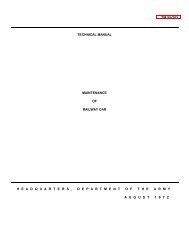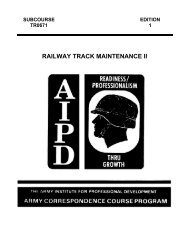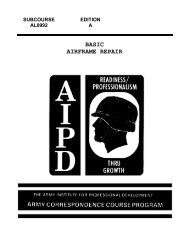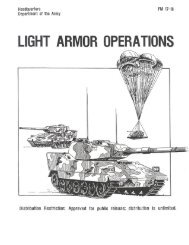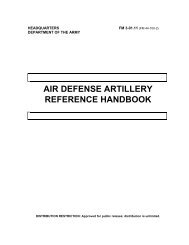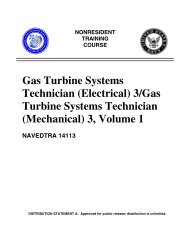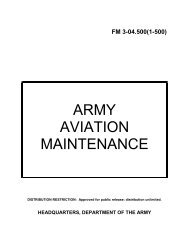fm 44-100 us army air and missile defense operations
fm 44-100 us army air and missile defense operations
fm 44-100 us army air and missile defense operations
Create successful ePaper yourself
Turn your PDF publications into a flip-book with our unique Google optimized e-Paper software.
FM <strong>44</strong>-<strong>100</strong><br />
4-2<br />
effective units. In a multi-component unit, AC soldiers perform the day to day<br />
<strong>and</strong> perishable skill duties. The AC soldiers are available to respond to<br />
immediate small-scale contingencies <strong>and</strong> pre-mobilization requirements. RC<br />
soldiers are integrated within the unit, train with the unit, <strong>and</strong> are available<br />
to fully man the unit in crisis situations. Planning for the integration of<br />
reserve components <strong>and</strong> civilians is essential to the successful conduct of<br />
ADA <strong>operations</strong>.<br />
TYPES OF FORCES<br />
4-7. ADA has a wide mix of forces available to accomplish the mission. ADA<br />
units can be long range or short range, high or low altitude, <strong>and</strong> mobile or<br />
semi-mobile. Individual systems may have widely varying capabilities<br />
against different threat classes. The comm<strong>and</strong>er task organizes the force to<br />
defeat the threat <strong>and</strong> protect the force. The comm<strong>and</strong>er m<strong>us</strong>t also integrate<br />
the efforts of combat support <strong>and</strong> combat service support forces.<br />
BALANCE<br />
4-8. Components of combat power can be joined in multiple ways based upon<br />
METT-TC. These combinations change over time <strong>and</strong> may be different in<br />
deep, close, <strong>and</strong> rear <strong>operations</strong>. Balance <strong>and</strong> a wide choice of employment<br />
options are key to success. Denial of threat RSTA activities is essential to<br />
protect friendly forces <strong>and</strong> assets, <strong>and</strong> to maintain surprise <strong>and</strong> the freedom<br />
to maneuver.<br />
COMBINED ARMS<br />
4-9. As the military prefers to fight as a joint team, the Army prefers to fight<br />
as a combined arms team. ADA is part of the simultaneo<strong>us</strong> application of the<br />
combat functions in every operation. These arms <strong>and</strong> services are integrated<br />
horizontally at each comm<strong>and</strong> level, normally battalion through corps, <strong>and</strong><br />
vertically between comm<strong>and</strong> echelons. Combined arms teams strive to<br />
conduct fully integrated <strong>operations</strong> in the dimensions of time, space, purpose,<br />
<strong>and</strong> resources. Combined arms forces operate over increasingly large areas of<br />
the battlefield with less force density than in the past. Modern combined<br />
arms warfare puts added stress on maintaining dispersed <strong>and</strong> noncontiguo<strong>us</strong><br />
formations. The application of combined arms is complex <strong>and</strong> dem<strong>and</strong>ing. It<br />
requires detailed planning <strong>and</strong> violent execution by highly trained soldiers<br />
<strong>and</strong> units that have been thoroughly rehearsed.<br />
4-10. At operational <strong>and</strong> tactical levels of war, freedom to maneuver is crucial<br />
to achieving superior combat power. Freedom to maneuver facilitates the<br />
ability of l<strong>and</strong> <strong>and</strong> <strong>air</strong> forces to shape the battlefield, achieve advantage, set<br />
the terms for combat <strong>and</strong> future <strong>operations</strong>, <strong>and</strong> exploit success. Freedom to<br />
maneuver is the catalyst that permits l<strong>and</strong>, <strong>air</strong>, <strong>and</strong> sea forces to reach their<br />
full destructive potential. Combined with the synergistic effect of<br />
synchronized surface <strong>and</strong> <strong>air</strong> <strong>operations</strong>, freedom to maneuver ultimately<br />
leads to success on the battlefield.<br />
4-11. The ability of any unit at any echelon to maneuver freely on the<br />
battlefield centers around reliable logistical support <strong>and</strong> effective battle<br />
comm<strong>and</strong>. Friendly forces m<strong>us</strong>t anticipate enemy efforts to deny or disrupt




